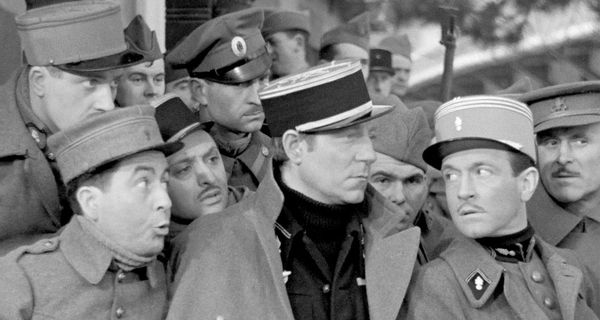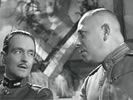Eye For Film >> Movies >> La Grande Illusion (1937) Film Review
La Grande Illusion
Reviewed by: Amber Wilkinson

People familiar with the steady stream of Second World War prison dramas that grace the British screens on most Bank Holidays, may find La Grande Illusion something of a surprise. Set in the earlier, First World War, the rules of engagement are different, with gentlemanly conduct at the heart of imprisonment. Although prisoners are taken, they are treated humanely and even invited to break bread with their captors. Here, it the idea of man’s humanity to man that is more important than the political machinations of war.
The action track pilots Captain de Boeldieu (Pierre Fresnay) and Lieutenant Maréchal (Jean Gabin) after they are shot down by the Germans. Although both officers, their lives back home are very different, with Boeldieu an aristocrat and Maréchal a working-class mechanic. Once ensconced in a PoW camp, they team up with a host of other characters – including a nouveau riche Jewish banker Rosenthal (Marcel Dalio) – and, after a tip-off from a departing English prisoner about a tunnel already under excavation, bid to make good an escape.

For many directors who followed, this would be enough premise on which to hang an entire movie, but for Renoir, it is only the tip of the iceberg as he goes on to track Boeldieu, Maréchal and Rosenthal’s procession through a series of camps until they end up in a fortress – run by wounded Captain von Rauffenstein (Eric von Stroheim) - from which they, again, try to orchestrate an escape.
Although there is plenty of action throughout La Grande Illusion, it is the characters that are key to the film’s message. Renoir and his co-writer Charles Spaak are at pains to point out that language is less of a barrier to communication than social strata, with Boeldieu shown as having much more in common with the equally aristocratic Rauffenstein, than with either the new money of Rosenthal or his comrade Maréchal. The connection for the prisoners is one of honour and duty to a country, rather than a meeting of shared experience. The scripting cleverly reinforces this, with German, English and French all used to good effect.
The social message comes thick and fast as Boeldieu and Rauffenstein are used to symbolise a passing age of aristocracy – soon to be as dead as many of the boys in the trenches, the implication being that it is the ‘common man’ who will survive.
The influence of La Grande Illusion on war films that followed is clear to see. The digging of the tunnel provides the pattern for films such as The Wooden Horse (1950) and The Great Escape (1963), while the idea of failed escapees making a bid for freedom from impregnable fortresses would, of course, resurface in later classics such as The Colditz Story (1955). The humour used to illustrate the camaraderie between the prisoners is similar to that featured by Billy Wilder in Stalag 17 (1953) and even the idea of the French national anthem La Marseillaise being employed as a ‘weapon’ against an opposing force would reappear in Casablanca (1942).
Renoir’s camerawork is elaborate, with many scenes carefully framed so that the camera creeps across them like a roving eye, making fresh discoveries as it travels. While this may look slightly melodramatic by today’s standards, at the time it was breaking new ground and would go on to be emulated by many. The urge to reduce Renoir by talking merely about technique should be resisted, however, since it is the vibrancy and vividness with which he paints his picture of human relationships that should be held up for praise. The script sears like a whip-crack, with one-liners peppering the action, yet never getting in the way of the film’s emotional depth.
With decades now passed since the film was first released, it is also easy to forget how strong its humanist message seemed at the time. In 1937 it won a prize at the Venice Film Festival but was shortly afterwards condemned as “cinematic public enemy No.1” by Joseph Goebbels – who doubtless didn’t see the joys of its anti-war undercurrent and ordered it destroyed. As luck would have it, the original negative did, in fact, survive and was rediscovered in the early 1990s, meaning that the print has never looked so good.
While La Grande Illusion is in many ways, triumphant in terms of technique, its greatest strength lies in the story – and, for that, it deserves to be celebrated.
Reviewed on: 24 Jun 2007
















